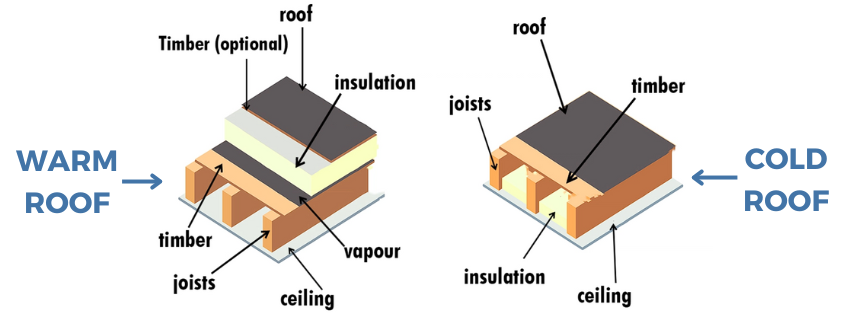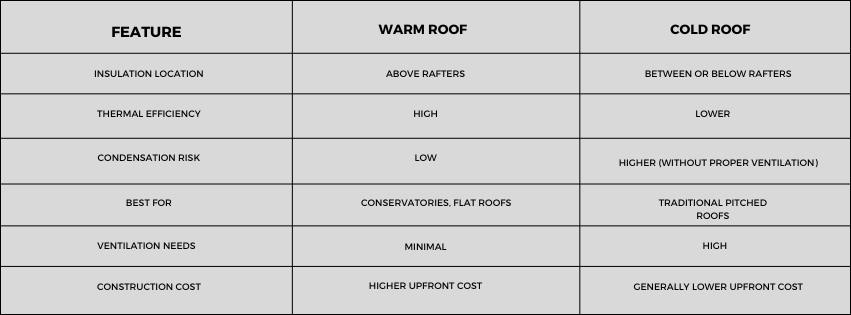Choosing between a warm roof and a cold roof might seem straightforward—but it’s not just about keeping the rain out. Did you know that one can reduce energy bills by up to 30% compared to the other? The right choice could mean the difference between a cozy, energy-efficient space and a room that’s too hot in summer and freezing in winter. In this article, we’ll dive into the ins and outs of both options, breaking down which design suits your specific project and why it matters. Ready to make an informed decision? Let’s get started!

What is a Warm Roof?
A warm roof is designed to keep the entire structure insulated, meaning the insulation layer is placed above the rafters or structural decking. This placement keeps the roof space and its components, like beams and rafters, within the thermal envelope of your home. By minimising heat loss, warm roofs offer superior thermal efficiency and help reduce energy bills.
Key Features of a Warm Roof:
- Insulation Above the Deck: This type of construction ensures that the entire roof system stays warm, reducing the risk of condensation.
- Prevention of Thermal Bridging: A continuous layer of insulation prevents heat from escaping through gaps.
- Suitable for Flat and Pitched Roofs: Popular in flat roof construction and conservatory warm roofs due to its energy-saving properties.
- Ideal for Conservatory Conversions: Warm roof conservatories offer better insulation, making them usable year-round.
Whether you’re opting for warm flat roof construction or upgrading to a warm roof conservatory, this type of roof is often preferred for its overall energy efficiency and long-term benefits.
What is a Cold Roof?
In a cold roof system, the insulation is placed between the rafters or beneath the roof deck, leaving the rafters exposed to outside temperatures. As a result, the roof space above the insulation remains cooler than the living space below, making this design more prone to temperature fluctuations and condensation.
Key Features of a Cold Roof:
- Insulation Between Rafters: This type of placement means the roof deck and rafters are not insulated, causing potential heat loss.
- Ventilation Requirements: Cold roof construction relies on proper ventilation to prevent condensation buildup and moisture issues.
- Less Energy Efficient: Compared to a warm roof, this option is less thermally efficient, which can impact energy bills.
- Best for Loft Spaces: Typically used in pitched roofs where the roof void is not frequently used as living space.
Cold roofs are common in traditional builds, but they’re not as effective for modern energy efficiency standards. If you’re considering building a flat roof, a cold roof might not be the best choice.
Warm Roof vs. Cold Roof: Which Should You Choose?
The decision between a warm roof and a cold roof often comes down to the specific requirements of your project and your goals for energy efficiency. Here’s a quick comparison to help you decide:

If energy efficiency and comfort are your priorities, a warm roof construction is typically the better option. However, if you’re looking for a cost-effective solution for spaces that don’t need to be thermally insulated year-round, a cold roof might suffice.
When to Use a Warm Roof in Conservatories
A warm roof conservatory is an ideal solution for homeowners looking to transform their conservatory into a more usable living space. With the insulation layer placed above the roof structure, this design helps maintain a consistent temperature, ensuring that your conservatory stays warm in the winter and cool in the summer.
Benefits of Conservatory Warm Roofs:
- Enhanced Energy Efficiency: Reduces heat loss, making it more energy-efficient.
- Improved Comfort: Creates a year-round usable space.
- Minimised Condensation Issues: The design significantly lowers the risk of moisture buildup.
Building a Flat Roof: Which is Better?
If you’re building a flat roof, a warm flat roof construction is usually recommended due to its superior insulation and reduced condensation risk. Here’s why:
- Better Temperature Regulation: A warm flat roof prevents the roof deck from freezing in winter and overheating in summer.
- No Ventilation Needed: Unlike cold roofs, warm flat roofs don’t require a separate ventilation system, simplifying the build.
However, cold roofs can still be used in flat roof projects, especially when cost or headroom is a concern. It’s all about balancing your budget and thermal needs.
Both warm and cold roof designs have their pros and cons, but for modern energy standards, warm roof construction is often the better option. It provides enhanced thermal efficiency, reduces condensation risks, and creates a more comfortable living environment—whether it’s for a flat roof, conservatory, or home extension.
Still, a cold roof can be a good choice for traditional builds or spaces that don’t require high insulation levels. By understanding the unique characteristics of each, you can make an informed decision that suits your project’s requirements.






